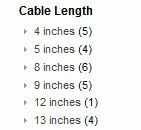The Serial ATA Revision 3.0 Specification makes no mention of minimum cable length that I could find, although the shortest cable length referenced in the standard is 1 meter.
The only reference I can find supporting the claim that shorter cables can cause timing or noise interference is from a paper entitled Successful SAS/SATA Equipment Design and Development: What You Need to Know for 6 Gb/s and Beyond:
If a cable is too short, however, de-emphasis and equalization may actually end up overcompensating for a signal, actually reducing signal integrity.
However, further reading of the paper makes it clear that this only applies to SAS-2 cables, not SATA (note emphasis):
Don’t use too short a cable for SAS-2:
While this may seem to contradict the previous point, SAS-2 employs
de-emphasis and equalization to attempt to overcome the effects of
attenuation and jitter. However, as endpoints don’t communicate as to
how much de-emphasis and equalization there should be, these values
are fixed within a range with expectation that they will work over
the specification’s supported cable lengths.
If a cable is too short, however, de-emphasis and equalization may actually end up overcompensating for a signal, actually reducing
signal integrity.
While the specification supposedly can work for any range of cable
length, if you encounter issues with short cables working with SAS-2,
try experimenting with longer lengths to determine if this is the
problem. Note that short cable issues do not apply to SATA as SATA
does not support de-emphasis or equalization.
Further, it seems that for SATA the shorter the cable the better:
Other ways developers can improve signal integrity include:
...
Use the shortest reasonable cable:
The longer the cable, the greater the attenuation. The best way to
reduce attenuation is by shortening cables. This is especially true
for SATA, where the absence of the SAS specification’s de-emphasis
and equalization mean that the link’s characteristics completely
control signal attenuation and jitter.
In conclusion: despite cables shorter than 1 metre not being part of the SATA specification, the shortness of a SATA cable does not inhibit its performance, and may even improve it.
Further Reading

What does the SATA specification indicate with regards to the length of the data cable? – Ramhound – 2017-11-07T23:03:44.273
@Ramhound No idea. – Hashim – 2017-11-07T23:10:54.907
2
The SATA spec makes no mention of cable length that I could find.
– DavidPostill – 2017-11-07T23:17:45.437@DavidPostill How did you manage to find the spec? The closest I got was running up against this, so I assumed it wasn't freely available.
– Hashim – 2017-11-07T23:19:59.0501@Hashim Google-fu :) I searched for "sata spec" and it was the 3rd link ... – DavidPostill – 2017-11-07T23:29:13.350
@DavidPostill Wow, I must have gone past that about 4 times. Well played. – Hashim – 2017-11-07T23:34:07.253
1I've used 8-inch cables for months with no detectable issues. – Ignacio Vazquez-Abrams – 2017-11-07T23:44:05.360
1I've used <12 inch SATA cables, not certain of the precise length – Christopher Hostage – 2017-11-08T00:17:58.927
2I've worked with Dell and HP SFF systems that have 6" SATA cables, never encountering a problem attributable to the data cable. Such Tier 1 OEM systems undergo considerable reliability testing before being mass produced. – I say Reinstate Monica – 2017-11-08T19:51:08.383